Thought this might help others. I’ve recently treated and successfully healed prolapsed cloaca in 3 week old Partridge Cochin chick, never had to treat prolapsed cloaca in a chick before, typically only older hens due to egg binding or others conditions. However, I used similar treatments. Ginger is fully recovered and thriving at 5 weeks old now.
Please note entire healing process takes 8-12 days (depending on age of bird and severity) with lots of vigilance and patience. It’s similar to treating ruptured hemorrhoids in humans, a very sensitive area that’s hard to keep infection free.
Step 1- recognize what a prolapsed cloaca looks like and understand what happened (anus/vagina has bulged outside the vent causing a ‘red cone’ where there should be a normal puckered cloaca). See photos of Ginger on day 1 when it happened due to an oversized poo, which had to be massaged out of her after she could not complete. Not sure what caused impaction as her other 11 flocks mates were fine. In adult hens this prolapsed ‘red cone’ may happen when egg binding, impaction of vent, or calcium deficiency is occurring.
Step 2- make a sugar solution in a small bowl or container, this will decrease inflammation (2tbs table sugar or cane sugar in 1/2 C warm water). It’s hard to dip a cloaca in solution so you can gently hold chick over bowl and use a wash rag to continuously drip sugar solution over inflammation. Do this twice a day for about 5 minutes each time. Keep
solution warm (not hot). Treat in this way for 2-3 days.
Step 3- after washing with sugar solution gently rinse with plain warm water and apply Manuka honey using a cotton swab. Manuka honey is an antiseptic/ moisturizer- put it around inflamed area; it’s okay if it gets inside vent during application. Do not insert anything into the vent.
Step 4- day 3-4 switch to epsom salt cleansing solution to stave off infection. Make a solution using 1 TBS epsom salt in 1 cup warm water, this solution is drying to sensitive skin so do not over concentrate it by adding extra salt. Hold chicks rear end over bowl and use rag to squeeze out solution over the cloaca. Keep solution warm. Do this twice a day for 2-3 days. After treating, rinse with plain warm water and clean rag. Try not to get the chick’s body wet, as they get chills easily. Apply Manuka honey and/or petroleum jelly generously around cloaca and surrounding area. Feathers around vent might be lost at this point due to irritation, they will return eventually don’t worry. If your chick is upset or chilly please cuddle warmly or place back to m brooder near lamp.
Step 5- by day 5-7, you should stop cleansing with Epsom salt solution unless it’s needed to wash away excess poo or scabbing. Cloaca will naturally scab as it heals and might even produce black or dark scabs. Never pick off scabs. By now the skin is dry and needs extra moisture to heal. You may gently rinse with warm water or use veterycin spray if necessary. Redness should be gone at this ponit. After a week of cleanse it’s time to focus on moisturizer for cloaca to heal properly because it’s a mucous membrane. Start applying petroleum jelly 3-4 times a day or as needed to keep cloaca and surrounding skin supple so it can heal without producing hard scabs. The birds will be upset by hard scabs and do anything to preen them away, causing bleeding and possibly infection. Apply Manuka honey for overnight as extra protection.
Step 6- (optional)- if other birds pick on afflicted chick you can find blue tinted ointment (hen healer) that disguises sore area but it needs to be applied over petroleum jelly when used on a cloaca. It does not add enough moisture when used alone.
In closing, the most important part of treating a prolapsed cloaca is cleansing and moisturizing. It’s an extremely sensitive area and by the nature of an animal with a cloaca when you apply pressure to that area, they have an instinct to push against the pressure. Therefore, when treating this area be very gentle and expect lots of poop to come out as you treat. It is painful for them to poop while dealing with prolapse and it’s not uncommon for them to cry or make baleful chirping sounds. Always clean poop away before applying Manuka honey and/or petroleum jelly.
By around 2 weeks your bird should have a normal functioning cloaca. Photos included of Ginger during treatment from day 1 until day 11. She’s even better now, frisky, eating voraciously and has fluffy bum feathers reappearing!
Please note entire healing process takes 8-12 days (depending on age of bird and severity) with lots of vigilance and patience. It’s similar to treating ruptured hemorrhoids in humans, a very sensitive area that’s hard to keep infection free.
Step 1- recognize what a prolapsed cloaca looks like and understand what happened (anus/vagina has bulged outside the vent causing a ‘red cone’ where there should be a normal puckered cloaca). See photos of Ginger on day 1 when it happened due to an oversized poo, which had to be massaged out of her after she could not complete. Not sure what caused impaction as her other 11 flocks mates were fine. In adult hens this prolapsed ‘red cone’ may happen when egg binding, impaction of vent, or calcium deficiency is occurring.
Step 2- make a sugar solution in a small bowl or container, this will decrease inflammation (2tbs table sugar or cane sugar in 1/2 C warm water). It’s hard to dip a cloaca in solution so you can gently hold chick over bowl and use a wash rag to continuously drip sugar solution over inflammation. Do this twice a day for about 5 minutes each time. Keep
solution warm (not hot). Treat in this way for 2-3 days.
Step 3- after washing with sugar solution gently rinse with plain warm water and apply Manuka honey using a cotton swab. Manuka honey is an antiseptic/ moisturizer- put it around inflamed area; it’s okay if it gets inside vent during application. Do not insert anything into the vent.
Step 4- day 3-4 switch to epsom salt cleansing solution to stave off infection. Make a solution using 1 TBS epsom salt in 1 cup warm water, this solution is drying to sensitive skin so do not over concentrate it by adding extra salt. Hold chicks rear end over bowl and use rag to squeeze out solution over the cloaca. Keep solution warm. Do this twice a day for 2-3 days. After treating, rinse with plain warm water and clean rag. Try not to get the chick’s body wet, as they get chills easily. Apply Manuka honey and/or petroleum jelly generously around cloaca and surrounding area. Feathers around vent might be lost at this point due to irritation, they will return eventually don’t worry. If your chick is upset or chilly please cuddle warmly or place back to m brooder near lamp.
Step 5- by day 5-7, you should stop cleansing with Epsom salt solution unless it’s needed to wash away excess poo or scabbing. Cloaca will naturally scab as it heals and might even produce black or dark scabs. Never pick off scabs. By now the skin is dry and needs extra moisture to heal. You may gently rinse with warm water or use veterycin spray if necessary. Redness should be gone at this ponit. After a week of cleanse it’s time to focus on moisturizer for cloaca to heal properly because it’s a mucous membrane. Start applying petroleum jelly 3-4 times a day or as needed to keep cloaca and surrounding skin supple so it can heal without producing hard scabs. The birds will be upset by hard scabs and do anything to preen them away, causing bleeding and possibly infection. Apply Manuka honey for overnight as extra protection.
Step 6- (optional)- if other birds pick on afflicted chick you can find blue tinted ointment (hen healer) that disguises sore area but it needs to be applied over petroleum jelly when used on a cloaca. It does not add enough moisture when used alone.
In closing, the most important part of treating a prolapsed cloaca is cleansing and moisturizing. It’s an extremely sensitive area and by the nature of an animal with a cloaca when you apply pressure to that area, they have an instinct to push against the pressure. Therefore, when treating this area be very gentle and expect lots of poop to come out as you treat. It is painful for them to poop while dealing with prolapse and it’s not uncommon for them to cry or make baleful chirping sounds. Always clean poop away before applying Manuka honey and/or petroleum jelly.
By around 2 weeks your bird should have a normal functioning cloaca. Photos included of Ginger during treatment from day 1 until day 11. She’s even better now, frisky, eating voraciously and has fluffy bum feathers reappearing!

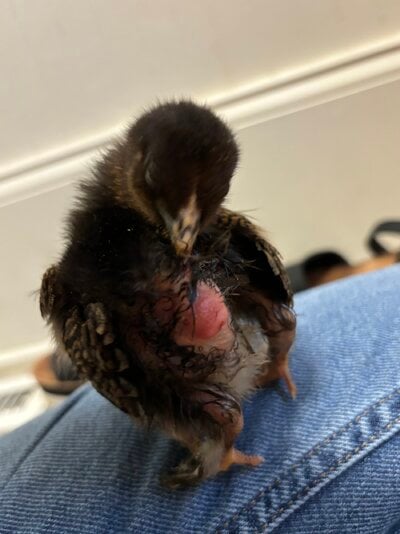




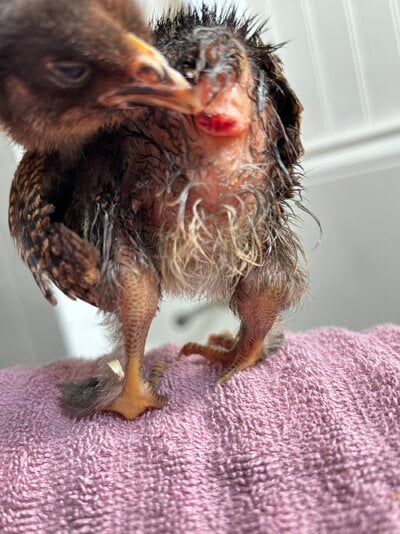
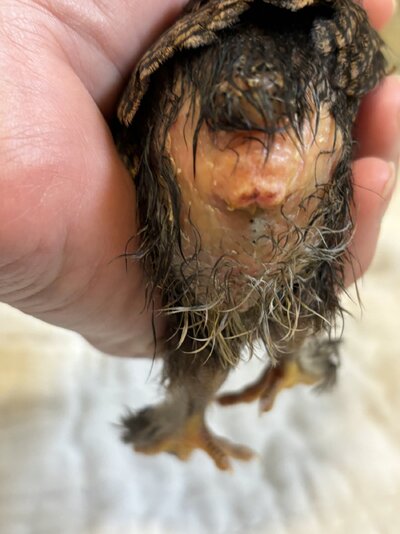
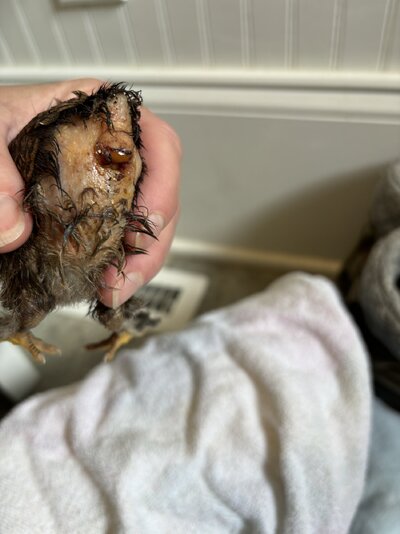
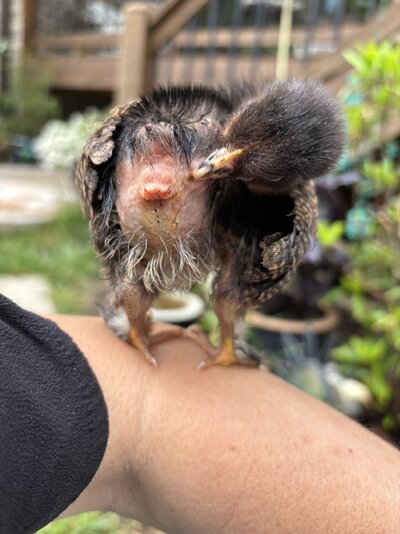
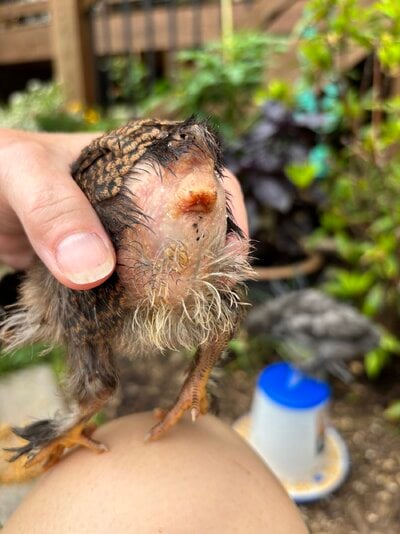

I’m raising a lovely sage gem with dislocated beak (scissors beak) pullet currently (she would have been otherwise culled), she’s one of the smartest hens I’ve had experience with, a fighter and adapter. Will to live!